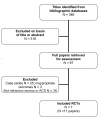Spinal cord stimulation in the treatment of refractory angina: systematic review and meta-analysis of randomised controlled trials
- PMID: 19320999
- PMCID: PMC2667170
- DOI: 10.1186/1471-2261-9-13
Spinal cord stimulation in the treatment of refractory angina: systematic review and meta-analysis of randomised controlled trials
Abstract
Background: The aim of this paper was undertake a systematic review and meta-analysis of the use of spinal cord stimulation (SCS) in the management of refractory angina.
Methods: We searched a number of electronic databases including Medline, Embase and Cochrane Library up to February 2008 to identify randomised controlled trials (RCTs) reporting exercise capacity, ischemic burden, functional class, quality of life, usage of anti-anginal medication, costs and adverse events including mortality. Results were reported both descriptively for each study and using random effects meta-analysis. Given the variety in outcomes reported, some outcome results were pooled as standardised mean differences (SMD) and reported in standard deviation units.
Results: Seven RCTs were identified in a total of 270 refractory angina patients. The outcomes of SCS were found to be similar when directly compared to coronary artery bypass grafting (CABG) and percutaneous myocardial laser revascularisation (PMR). Compared to a 'no stimulation' control, there was some evidence of improvement in all outcomes following SCS implantation with significant gains observed in pooled exercise capacity (SMD: 0.76, 0.07 to 1.46, p = 0.03) and health-related quality of life (SMD: 0.83, 95% CI: 0.32 to 1.34, p = 0.001). Trials were small and were judged to range considerably in their quality. The healthcare costs of SCS appeared to be lower than CABG at 2-years follow up.
Conclusion: SCS appears to be an effective and safe treatment option in the management of refractory angina patients and of similar efficacy and safety to PMR, a potential alternative treatment. Further high quality RCT and cost effectiveness evidence is needed before SCS can be accepted as a routine treatment for refractory angina.
Figures





References
-
- Mannheimer C, Camici P, Chester MR, Collins A, DeJongste M, Eliasson T, Follath F, Hellemans I, Herlitz J, Lüscher T, Pasic M, Thelle D. The problem of chronic refractory angina; report from the ESC Joint Study Group on the Treatment of Refractory Angina. Eur Heart J. 2002;23:355–70. doi: 10.1053/euhj.2001.2706. - DOI - PubMed
Publication types
MeSH terms
LinkOut - more resources
Full Text Sources
Other Literature Sources
Medical

